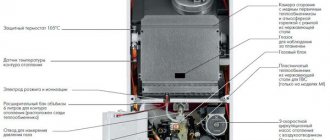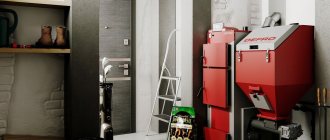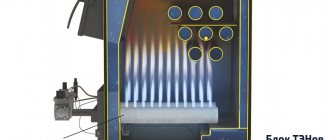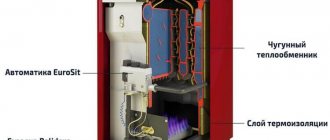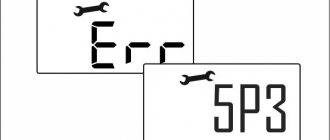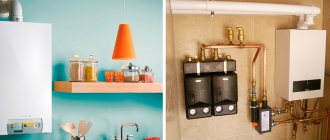How it all began
At one time, gas boilers of the AGV-80 or AGV-120 brand were used to heat a private house. This equipment had low productivity, but given the low cost of gas, this fact did not bother anyone.
AGV gas boilers for private homes were equipped with primitive automation, which failed in the first year of operation. However, the equipment functioned normally without it.
Installation of pipes for distribution is carried out outside around the perimeter of the house. However, this issue was not relevant at that time, and heat was supplied to the house in full. Pipes were used with a diameter of 2 inches, since a smaller diameter could cause the formation of air pockets that impede the natural circulation of the coolant.
After a slight modernization, gas boilers for heating AOGV and AOKGV appeared on the market, but this equipment was characterized by the same shortcomings (low performance and unreliable automation).
Despite this, boilers of this type have held up quite confidently on the market due to a serious advantage: the AGV heating stove operates without being connected to a power supply.
Other advantages of a heating system using AGV include the following:
- If we compare imported equipment and AGV, we note the affordable cost of the latter option.
- In contrast to the AOGV and the gas boiler produced by domestic manufacturers, the efficiency of the AGV can be noted.
The listed characteristics help in deciding what is better: an AOGV or a boiler.
Classification of gas boilers for domestic use
A review of domestic gas boilers will be incomplete without considering the types of classification of these heating units:
- by location;
- by functionality.
Classification by location
Depending on the location and method of installation, autonomous gas domestic boilers are produced in two types:
- floor-mounted;
- wall type.
Floor-mounted domestic gas boilers are more powerful units (up to 1000 kW) that can provide heat and hot water to large homes. The boiler's performance is indicated in the instructions for its use to facilitate the selection of a unit for specific areas and operating conditions.
Important! The large volume of the water tank determines the significant weight and dimensions of such units, therefore, to install floor-standing equipment, it is necessary to specially equip a separate boiler room equipped with a chimney and ventilation.
The requirements for a home boiler room are determined by GOST and are mandatory. In particular, for gas boilers with a power of up to 30 kW, the room area must be at least 4 square meters and the volume must be 8 cubic meters.
A household wall-mounted gas heating boiler has compact dimensions, but its power is limited, since mounting a boiler with a large water tank on the wall places increased demands on the load-bearing capacity of the base.
Wall-mounted boilers can be easily installed in a utility room, kitchen, or bathroom. To save space, you can use an existing niche in the wall for installation. In this case, it is not necessary to allocate a separate room for the heating boiler; the necessary air flow into the combustion chamber and the removal of combustion products to the outside will be provided by a double-acting chimney - a coaxial one, replacing bulky traditional structures.
When installing it on the wall, according to the location of the boiler, markings are made, and then a hole is made according to the diameter of the coaxial chimney with an addition of 3-4 cm for subsequent complete sealing of the gaps with caulk or another method. The installation of additional air ducts or connection of this chimney to the common shaft of the house is not required.
If you want to have at home, in addition to heating, an autonomous hot water supply, a wall-mounted boiler should be selected with a heat output of at least 24 kW (not to be confused with the electrical power consumed by the unit).
Cascade gas boiler system
When designing the heating of private houses with a large area, in order to save money, they use a cascade of gas boilers of small and medium power, united by a single hydraulic and electrical system (not to be confused with the parallel connection of a group of boilers, where each of them is controlled separately).
This technology, depending on the time of year and the need for hot water, allows you to use not the only available huge floor-mounted unit, but the required number of boilers from a cascade.
Methods for controlling a cascade system of units may involve not only the use of a certain number of cascade boilers, but also a combination (using a cascade controller) of heating devices operating with different power settings.
The cascade system is installed from both floor-mounted boilers and wall-mounted units.
In addition to heating private housing, cascade technology for installing heating equipment, but with units of higher power, is used for heating public buildings (stations, shopping centers, exhibition and concert halls).
It is important to know! To heat an apartment with an area of 50-70 m2, 5-10 kW of the total heat output of the boiler is sufficient. The remaining power will be required to heat water in the DHW system. The more hot water intake points, the more powerful the boiler should be.
If the power of the unit is not enough to provide the required volume of SGW, an additional device is installed - an indirect heating boiler, which is connected by piping to the gas boiler.
Classification by functionality
The division of boilers by type of placement is directly related to the functionality of the gas unit, which depends on the number of circuits in the design of the device - one or two.
Single-circuit boilers are used only for heating residential premises, which is provided by the only water circuit available in the design of the unit.
For the full life support of a residential property, double-circuit gas boilers look more attractive, which, in addition to heating, ensure the functioning of the hot water supply system, using their second circuit for this. Double-circuit heating devices differ in the method of heating the coolant:
- flow-through;
- capacitive.
If the consumption of hot water is insignificant and the number of hot water intake points is small (1 or 2), it is better to use double-circuit boilers with instantaneous water heating. Such devices have less power and are economical.
If there is a significant need for hot water, you should purchase a double-circuit boiler with a capacitive method of heating water, but even in this case, its consumption has limits - if the consumption of hot water at a temperature of +450C and above exceeds 20-40 liters per day, then the boiler will not cope with heating premises, since it will only work to heat water.
Models of wall-mounted boilers with instantaneous heating are compact and quickly heat up hot water. The disadvantages of the design of such equipment are high gas consumption and a drop in coolant temperature with intensive consumption of hot water. The way out of this situation is to install a storage boiler, which will reduce fuel consumption and allow you to maintain the set coolant temperature. However, this operation will significantly increase the cost of installing a heating system, and besides, installing the boiler also requires a specific location.
For reference: owners of private houses, who have less limited living space than apartment residents, and who have single-circuit boilers at their disposal, can additionally install an indirect heating boiler of the required capacity as an alternative to a double-circuit unit.
Design features
Household gas heating equipment may have significant design differences and features, including differences in the material of manufacture of heat exchangers, which on this basis are divided into the following types:
- steel - for equipping budget models;
- cast iron - for floor-standing boilers;
- made of stainless steel – used in wall-mounted boilers;
- bimetallic (bithermal) - the most common type.
Each type of heat exchanger has its own advantages and disadvantages, so the heat exchanger must be selected based on operating conditions and personal preferences:
- Steel heat exchangers are cheap, but susceptible to corrosion.
- Cast iron products are practical and durable.
- bimetallic products are lightweight and therefore are installed in wall-mounted models of double-circuit boilers.
- heat exchangers made of stainless steel are strong, durable, do not change the chemical composition of water, but due to the high cost of the material and the complexity of the manufacturing technology, they have a high price.
Gas heating boilers are also classified according to the design of the combustion chamber:
- open type;
- closed firebox.
The difference between them is that when the wind blows, harmful combustion products may enter the room. In addition, the air required for gas combustion enters the open-type combustion chamber from the room, which leads to the burnout of oxygen in the room. Both of these factors require you to periodically ventilate your home.
And the closed type of combustion chamber isolates the combustion process from the atmosphere of the room, air enters there from the outside, and the oxygen in the room does not burn out.
Currently, condensing gas boilers and turbocharged units are gaining popularity, which, with lower fuel consumption, have greater efficiency, but, accordingly, a higher price.
Design
The main part of the AGV boiler is the tank, through which the water is heated and enters the heating system.
To understand what AGV heating is, you need to familiarize yourself with the process of its operation, it looks like this:
- The combustion gas heats the flame tube-heat exchanger located inside the tank.
- The heat from the pipe is transferred to the water in the tank.
- Gas combustion products are discharged through a chimney connected to a pipe.
- To maintain the required water temperature in the tank, there is a valve that automatically turns on to supply gas.
The heating system based on AGV includes the following elements:
- Expander.
- Rising supply pipe.
- Batteries.
- Top piping.
- Return pipe.
User manual
Activating the system is a rather complex procedure, so we will provide step-by-step instructions for using it.
- First you need to pour water into the device and check whether there is traction in it. You should also make sure that the temperature control lever is closed.
- Next, open the tap to supply gas to the boiler.
- We open the viewing window - to do this you need to move a special flap.
- We tighten the air regulators.
- We light the piece of paper, press the activation button and, holding it in this way, bring the burning piece of paper to the igniter through the window.
- After thirty to sixty seconds, the button should be released, and the fire on the igniter should remain. If this does not happen, the operation is repeated.
But the main burner is ignited as follows:
- Turn the temperature dial until the main burner lights up.
- Adjust the air supply until the fire turns bluish.
- We set the temperature mode we need.
Important! In order to avoid “pops” during fire, make sure that the temperature and air regulators are in the full position each time.
Principle of operation
The system works on the following principle:
- According to the laws of physics, warm water rises up the rising supply pipe.
- Then it goes to the batteries, where heat exchange occurs and the water is cooled.
- The coolant with a lower temperature flows into the return pipe, from where it again goes to the heating tank.
The heating tank in such a system is located above the radiators, which promotes the natural movement of coolant in the system.
AGV heating systems operating on this principle are called thermosiphon or gravity, in which water circulates naturally. When heated, the volume of water increases, and its excess enters an expander installed at the highest point of the system.
The overflow tube helps drain water from the expander back into the system. Consequently, the water in the expansion tank partially compensates for the water lost in the system. And free access of air into the expander regulates the pressure.
To force coolant circulation, you can embed a pump into the system, but for this a power supply must be provided.
An automatic AGV device is necessary to stop the gas supply when there is weak draft, low pressure or the igniter goes out.
Functions of gas heating water heaters
In addition to functions that create operational safety (complete shutdown of operation when gas pressure decreases, draft in the ventilation system disappears, pressure in the heating system decreases), gas AOGV is equipped with additional options:
- Auto-ignition - automatic ignition of the burner after gas supply. Fuel economy due to the absence of an apron.
- Turbification is a forced ventilation that involves taking air from the street and burning gas in a closed chamber. The great advantage of forced draft is the possibility of installation in any room without the presence of vertical air ducts.
- Flame, draft, level, coolant pressure sensors.
- Electronic scoreboard.
- Digital (push-button, touch) control.
Each additional function increases the price of AOGV.
Improvement of AGV by the manufacturer
The obvious advantages of gas water heating units became the reason for their further production.
But the equipment required serious modifications and improvements, so the design underwent the following changes:
- Fragile glass thermometers were replaced by more reliable Italian instruments.
- American automation from Honeywell began to be used.
- The device is turned on using a piezo ignition system.
- Changing the appearance thanks to the application of coatings using new technologies.
Wall and floor boilers
Depending on the installation method, heating units are divided into compact wall-mounted models and more powerful floor-mounted modifications. The design option is determined by a combination of unit power, size and material of the heat exchanger. A large number of compact models, adapted for placement in limited space, make it possible to organize autonomous heating of a city apartment or a small country building as conveniently as possible.
Wall boilers
The range of gas boilers includes a wide variety of wall-mounted models, characterized by a dense layout, relatively low weight and guaranteed operational reliability. Wall-mounted devices can be installed in any room without creating an isolated room for the boiler room.
Compact wall-mounted gas boilers are available in single-circuit and double-circuit models, equipped with automatic protection and a convenient control system. The presence of an informative display simplifies setting the optimal modes. Displaying error codes ensures quick recovery of equipment when malfunctions occur.
Floor standing boilers
More powerful floor-standing models equipped with steel or cast iron heat exchangers are designed for heating large residential buildings, shopping centers and industrial facilities. The design of floor-standing units, equipped with effective thermal insulation, ensures rational use of fuel with a maximum level of efficiency. For the safe placement of heavy units, it is necessary to prepare a concrete site with sufficiently high mechanical strength.
Powerful floor-standing gas boilers are equipped with steel or cast iron heat exchangers, which have individual operating advantages. Most floor-standing models are equipped with automation, for the operation of which the unit must be connected to an electrical outlet. Integrated automation performs the most important tasks of regulating operating conditions and protecting equipment from incorrect operation. For places with unstable power supply, non-volatile modifications of gas boilers are optimal, maintaining standard performance during emergency power outages.
Rules for operating a heating system based on AOGV
Before choosing an AGV, you need to familiarize yourself with the basic rules.
The boiler should be installed in an isolated room, since turning on the unit is accompanied by a loud bang. Some modifications can boast of partially eliminating this problem. In them, after heating the water to a certain temperature, the burner does not turn off, but switches to the minimum flame mode.
The chimney for removing combustion products must have a diameter of at least 14 cm and be installed outside the house. It is also necessary to make a kind of pocket where objects that accidentally fall into the channel will be collected. The waste container should be placed under the connection between the chimney and the heating tank pipe.
Composition of the AGV system
The AGV system for heating devices consists of the following main elements:
- AGV boiler;
- pipelines;
- heating elements (radiators, registers);
- expansion tank, which is mounted above all other elements (necessary when starting the AGV heating system).
The basis of the AGV is the AGV boiler. It is a tank mounted in an iron casing, inside of which a pipe for burning gas is mounted. It looks like a samovar. The combusted gas heats the water flowing inside the tank. Gas combustion products are released into the atmosphere through the chimney.
The heated water enters the heating system, where, in accordance with the known laws of physics—hot water is lighter than cold—it flows through pipelines into heating radiators. There, having given up thermal energy, it cools and again enters the AGV for heating. This creates a closed circuit through which the coolant flows by gravity. Its driving force is the difference in height between the heating (AGV) and cooling devices (radiators). The greater this difference, the more intense the water circulation. Such a heating system is called a thermosiphon or a system with natural circulation of coolant. However, recently heating systems with forced water circulation have become increasingly used. In this case, a circulation pump is installed at the outlet of the AGW into the pipeline, which significantly increases the rate of water circulation and, as a result, reduces the time for heating the premises at a given temperature and the consumption of gas consumed. In this case, automation is used that maintains the specified parameters and monitors the fulfillment of basic safety requirements (switching off the gas supply when the water pressure in the line decreases or the burners go out).
Tips for operating a heating system with an AGV boiler in a private house
Operation of AGV requires compliance with precautionary measures for the safe operation of the system:
- A decrease in water temperature to 50 degrees leads to abundant release of condensate, the accumulation of which can cause the burner to go out.
- When condensate combines with combustion products, acid is formed, which negatively affects the metal parts of the boiler.
- Water in the system, cooled to 50 degrees, stops moving naturally in the system.
- If you plan to have a long break in the operation of the heating system, then it is necessary to drain the water. However, it should be remembered that the pipeline in this form is more susceptible to corrosion.
- Hot water in the AGV system is available without heating the entire system. For this purpose, a special tap is used to shut off the water circulation in the heating system. In order not to stop the flow of the coolant, you can make a direct connection between the supply and return pipes.
Generation of new heating systems
Modern models of gas boilers are more advanced in comparison with traditional analogues. Both single-circuit and double-circuit devices are available on sale. The first ones are intended only for heating.
The latter are capable of simultaneously performing two functions: heating the premises of the house and providing its owners with hot water supply.
Scheme: arrangement of single-circuit and double-circuit boilers
Innovations concern not only the design of the device itself, but the use of higher quality devices:
- The design now includes control and regulating devices that allow you to set different modes.
- In the ignition system, traditional handles have been replaced by piezoelectric elements.
- The casing coating is characterized by increased resistance to damage and durability.
They are convenient because they are able to operate smoothly and efficiently, without requiring constant human supervision. Sensors located on the body will indicate malfunctions, while at the same time identifying the system that has failed.
Thanks to the automatic AGV, in the event of a drop in gas pressure, unexpected extinguishing of the pilot flame and a decrease in draft, the system is instantly switched off, which is important for the safety of residents.
- The main elements of the automation unit are:
- Electromagnet – controls the gas supply valve;
- Thermal sensor – controls water heating;
- Draft sensor – monitors the draft level in the pipe;
- Thermocouple – creates an electric current in a circuit.
Modern boilers are as compact and automated as possible.
The gas supply to the burner is regulated by a thermostat. To ensure uninterrupted operation of the unit, you just need to set the desired parameters. When the shutter is automatically activated, the gas supply to the burner is reduced to a minimum, and the operation of the system is maintained only by a weakly burning wick.
As soon as the temperature sensor triggers to lower the temperature of the coolant, the automation starts and the wick ignites.
Non-volatile boilers
To build a reliable heating system in populated areas with unreliable power supply, it is advisable to purchase a non-volatile gas boiler that operates without being connected to the electrical network. Floor-standing boilers AOGV, presented by Teharmatura in models of various capacities, are adapted for efficient heating of residential buildings, commercial enterprises and industrial complexes. Advantages of AOGV boilers:
- Trouble-free operation in harsh climatic conditions;
- Maintaining operability at low pressure levels in the gas pipeline;
- Reliable automation that protects against operation in incorrect modes;
- Possibility of heating large buildings;
- Availability of modifications running on liquefied gas.
Adjustment of the fire intensity can be done manually or automatically. When operating models without a circulation pump, the heating pipes are given a certain slope during installation for efficient circulation of the heated coolant. The presence of an expansion tank ensures that optimal pressure is obtained for complete circulation of the coolant. A relatively high level of efficiency of non-volatile equipment is achieved by using a heat exchanger of a special design.


